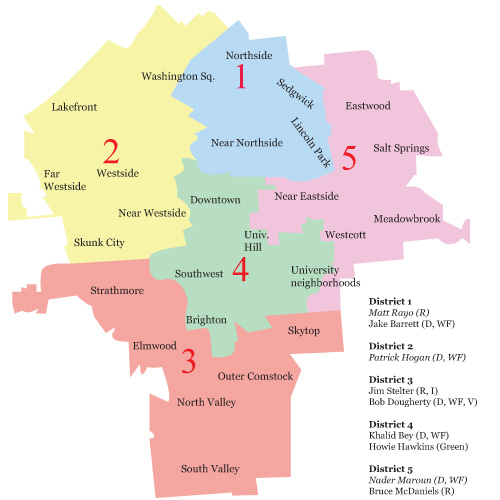To fix their potholes and plow their streets, voters can choose among 13 Common Council candidates this November.
Those include five district councilors and two councilors at-large.
The Common Council election is up-close-and-personal politics for citizens, say political experts. It is dark blue in partisanship, with heavy voter-enrollment advantage for Democrats. And the council will have to figure out how to keep government operations alive in a period of economic downturn.
The Common Council is the city’s most local level of politics. City Clerk John Copanas describes the character of Common Council politics as the “50-Foot Rule” for residents. The 50 feet is the close-up view of residents’ needs from their city government.
“Outside my door: Is my street being plowed? Is my trash being picked up? Do I feel safe in my neighborhood? How does my neighborhood park look?” said Copanas, who has watched the politics as city clerk for 19 years.
The election is Nov. 8.
Syracuse’s Common Council includes a president, four councilors at-large and five district councilors. The president’s seat is not up for election this year. It is held by Democrat Van Robinson.
As the city’s legislative branch, councilors pass ordinances, oversee the budget, and serve on committees that manage community improvement, among other duties that keep Syracuse running.
Council positions are part-time jobs. District councilors and councilors at-large each make $21,224 yearly.
District councilor terms last two years, while councilors at-large serve four. Councilors at-large may not serve more than two full terms, while the district councilors can serve no more than four consecutive terms, or eight years.
The election on Nov. 8 features four contested races. They are:
- District 1: Republican incumbent Matt Rayo vs. Democrat Jake Barrett.
- District 3: Republican Jim Stelter vs. Democrat Bob Dougherty in a seat left open by incumbent Ryan McMahon, who is running for the County Legislature District 15 seat.
- District 4: Democrat Khalid Bey vs. Green Party candidate Howie Hawkins in another open-seat race created by term-limits that keep incumbent Democrat Tom Seals from running again.
In the councilor-at-large race, two seats are open and four candidates are vying to fill them. Two are Democrats: incumbent Kathleen Joy and Helen Hudson. Two are Republicans: Joseph Rotondo and Kurt Schmeling.
In two districts, the seats are uncontested. In District 2, incumbent Democrat Pat Hogan is running unopposed. In District 5, incumbent Democrat Nader Maroun has an opponent on the ballot, Republican Bruce McDaniels. But McDaniels has told Democracywise that he is not campaigning.
Democrats dominate Syracuse’s Common Council and voter registration math gives the party a strong chance of staying in charge.
“It’s an overwhelmingly Democratic city,” said Grant Reeher, a Syracuse University political science professor. It is highly unlikely that majority control in the Common Council would change, he said.
Syracuse Democrats outnumber Republicans more than 3-to-1, according to voter registration data.
But that math does not necessarily decide district elections. In District 1, for example, 21 percent of voters are Republicans, while 46 percent are Democrat. That’s the smallest Democratic concentration in the city. The remaining 33 percent of voters of District 1 either stay unaffiliated or belong to one of the nine smaller parties.
In November 2009, District 1 elected Matt Rayo, the Republican, Conservative and Independent Party candidate, over incumbent Michael Heagerty, the Working Families candidate. Heagerty had originally been elected as a Democrat but could not run on the party’s ballot line because he failed to submit the proper number of signatures on his qualifying petition.
This election the big issue will be everything the city pays for. Budgets cuts throughout have dominated city government news.
For example, bowing to state education cuts, the Syracuse City School District slashed its budget nearly $20 million and about 470 jobs, The Post-Standard has reported. And the city has closed the downtown Ida Benderson Senior Center because it could not afford to pay the center’s rent.
In this electoral cycle, said SU political scientist Reeher, local politicians will have to figure out how to do more with less. “When you have periods of economic downturn,” said Reeher, “the demands of services go up, the revenue goes down.”
(Eric Vilas-Boas is a senior with dual majors in magazine journalism and English and textual studies.)
-30-



